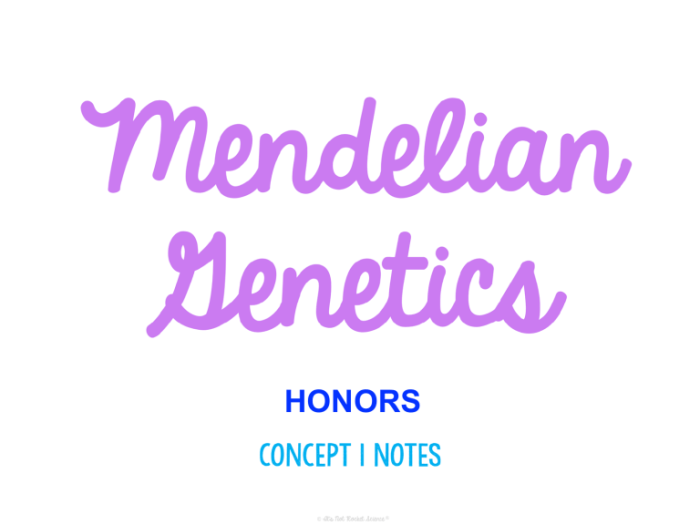Concept 1 notes mendelian genetics – Concept 1 notes on Mendelian genetics unveil the fundamental principles that govern the transmission of traits across generations. This groundbreaking work laid the foundation for our understanding of heredity, providing insights into the mechanisms that shape the diversity of life.
Mendelian genetics, pioneered by Gregor Mendel in the mid-19th century, established the concept of dominant and recessive alleles, genotype and phenotype, and introduced the principles of segregation and independent assortment. These principles have revolutionized our understanding of inheritance patterns, providing a framework for predicting the probability of offspring inheriting specific traits.
1. Definition and Principles of Mendelian Genetics
Mendelian genetics, founded by Gregor Mendel, is the study of how traits are inherited from parents to offspring. It provides a fundamental understanding of the transmission of genetic information.
Key concepts in Mendelian genetics include:
- Alleles:Different forms of a gene that occupy the same locus on homologous chromosomes.
- Genotype:The genetic makeup of an individual, consisting of the alleles present at a particular gene locus.
- Phenotype:The observable characteristics of an individual, resulting from the interaction of its genotype with the environment.
- Dominance:The phenomenon where one allele masks the expression of another allele in a heterozygous individual.
- Recessive:An allele that is only expressed in a homozygous individual.
Mendelian inheritance patterns can be predicted using:
- Monohybrid crosses:Crosses involving individuals that differ in only one gene locus.
- Dihybrid crosses:Crosses involving individuals that differ in two gene loci.
2. Laws of Inheritance

Mendel formulated three laws of inheritance that govern the transmission of genetic traits:
Law of Segregation
During gamete formation, the two alleles for each gene segregate and are distributed randomly into different gametes.
Law of Independent Assortment
The alleles of different genes assort independently of each other during gamete formation.
Law of Dominance
In a heterozygous individual, the dominant allele masks the expression of the recessive allele.
These laws provide a framework for understanding the inheritance of traits and predicting the outcomes of genetic crosses.
3. Applications of Mendelian Genetics

Mendelian genetics has wide-ranging applications in various fields:
Agriculture
- Improving crop yields by selecting for desirable traits
- Developing new varieties of plants and animals
Medicine
- Diagnosing and treating genetic disorders
- Developing personalized medicine based on genetic information
Biotechnology
- Creating genetically modified organisms for various purposes
- Developing new biopharmaceuticals and diagnostic tools
4. Extensions of Mendelian Genetics
Mendelian genetics has been expanded to account for more complex inheritance patterns:
Incomplete Dominance
Both alleles are expressed in a heterozygous individual, resulting in an intermediate phenotype.
Codominance
Both alleles are fully expressed in a heterozygous individual, resulting in a distinct phenotype.
Multiple Alleles, Concept 1 notes mendelian genetics
More than two alleles exist for a particular gene locus, resulting in more complex inheritance patterns.
Polygenic Inheritance
Multiple genes contribute to the expression of a single trait, resulting in a continuous range of phenotypes.
Environmental Factors
Environmental factors can influence gene expression and phenotype.
5. Limitations of Mendelian Genetics: Concept 1 Notes Mendelian Genetics
Mendelian genetics has limitations in explaining certain inheritance patterns:
Complex Traits
Many traits are influenced by multiple genes and environmental factors, making it difficult to predict inheritance patterns.
Epigenetics
Environmental factors can modify gene expression without altering the DNA sequence, resulting in phenotypic changes that can be inherited.
Despite its limitations, Mendelian genetics remains a fundamental framework for understanding the inheritance of traits and provides a foundation for further genetic research.
Question & Answer Hub
What is the difference between genotype and phenotype?
Genotype refers to the genetic makeup of an individual, while phenotype refers to the observable characteristics that result from the expression of genes.
What is the law of independent assortment?
The law of independent assortment states that the alleles of different genes assort independently of one another during gamete formation, meaning that the inheritance of one trait does not influence the inheritance of another.
What are the limitations of Mendelian genetics?
Mendelian genetics cannot explain complex traits that are influenced by multiple genes or environmental factors, nor can it account for the role of epigenetics in gene expression.